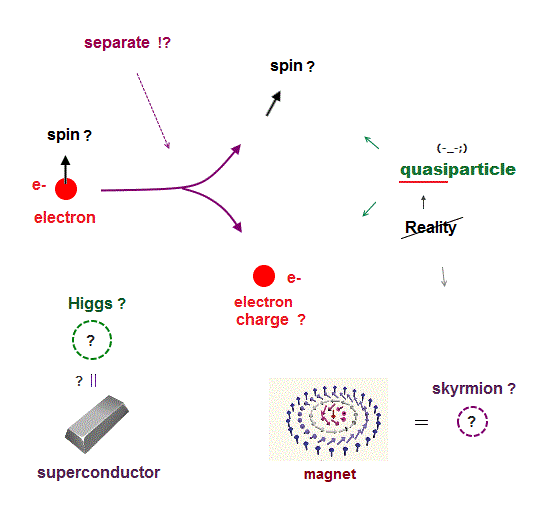
Home page
Quasiparticle is unreal, overhyped
(Fig.1) Quantum mechanics says an electron splits into three unreal quasiparticle models of spinon (= spin ? ), holon (= charge ? ), orbiton (= orbit ) ?

Quantum mechanics is useless, unable to describe multi-electron phenomena, so it has to rely on various fictional quasiparticle models with fake mass and charge to approximately express multi-particle physical phenomena.
↑ Quantum mechanics relying on fictional quasiparticle model means the quantum mechanics can Not clarify the real detailed physical mechanism of material by real electron or atomic model, hence hampers technology.
Quantum mechanics ridiculously claims that a single electron, which must be indivisible ( this p.2 ), could split into spin expressed as fictitious spinon quasiparticle and charge expressed as fictitious holon quasiparticle through unrealistic process called "spin-charge separation" ( this p.3-15 ).
↑ Of course, a real electron can Not be divided, so this quantum mechanical spinon quasiparticle model is unreal and paradoxical, hence impractical forever, but physicists still try to continue to publish papers on these fictional quasiparticle model in vain.
These fictional spin-charge separated quasiparticles mean a hole after an electron is kicked out by light moves in one direction, and the material's magnetization (= by electron's orbit, Not spin ) moves in different direction ( this-right ), which is estimated by X-ray scattering image (= Not by directly seeing the unreal spinon quasiparticle, this-2nd-last-paragraph ) .
↑ It is Not an electron really splitting into (fictional) spin and charge quasiparticles.
Quantum mechanical also claims an indivisible electron could split into three quasiparticles of spinon (= spin ), holon (= charge ), and orbiton (= orbit ).
↑ This orbiton just means some excited electron's state (= this excited energy state moving in different direction from the material's magnetization, this-left, this 11~13th-paragraphs ), and does Not mean an electron really splits into three (fictional) quasiparticles.
Because quasiparticles are Not real particles.
This hyped news' last paragraph says
"It's all basic research but we hope this (= unreal spinon quasiparticle ) is very relevant for understanding superconductivity in cuprate"
← fake news
↑ This research paper on fictional spinon-charge-orbiton quasiparticles ( this ↓)
p.2-abstract says nothing about any practical application such as superconductivity, contrary to the above hyped news.
p.7-8 quantum mechanics can only express these (fictional) spin or spinon quasiparticles as nonphysical math operators or very old impractical model such as Heisenberg spin (= S ) model with No actual atomic shapes.
p.17-left-a shows the electron excited by light (= orbiton ? ) moved to the right, and the magnetization (= spinon ) moved to the left (= imagined by X-Ray, Not by directly seeing fictional spin or quasiparticles ). ← This does Not show an electron actually split into spin, charge and orbit.
p.21 chose adjustable parameters and artificial spin model (= No quantum mechanical prediction, this-p.5.p.7.p.8--left-2. ).
↑ This-p.7(or p.6)-2nd~3rd-paragraphs say
"We
first considered the Heisenberg model without disorder. By tuning the values of J1, J2, and Jh" ← Just artificially adjusting free parameters J without quantum mechanical prediction.
The 1st, 5th paragraphs of this hyped news (7/7/2025) say
"have described how a so-called lone spinon (= fictional magnetic quasiparticle ) The discovery.. could (= just speculation ) have implications for the development of future (= still unrealized ) technologies such as (hopeless) quantum computers and new magnetic materials"
"In 1931, Hans Bethe proposed a mathematically elegant solution to one of the fundamental quantum models of magnetism—the so-called one-dimensional Heisenberg model (= ancient impractical quantum spin equation lacking real particle shape )
as if an indivisible electron splits into two more fundamental particles (← impossible ).
"
↑ This research paper ( this ↓ )
p.1-abstract says nothing about any practical application such as quantum computers, contrary to the above hyped news.
p.11-SIII.24 shows this research (= just theory, No experiment ) tried to express the fictional spinon quasiparticle by the very old unphysical math symbol model and free parameters (= J ) with No quantum mechanical prediction nor practical application.
↑ In this way, there is always a wide discrepancy between the overhyped fake news and the actual paper to hide the fact that today's quantum mechanical researches are deadend, impractical due to the fictional quasiparticle model.

Feel free to link to this site.